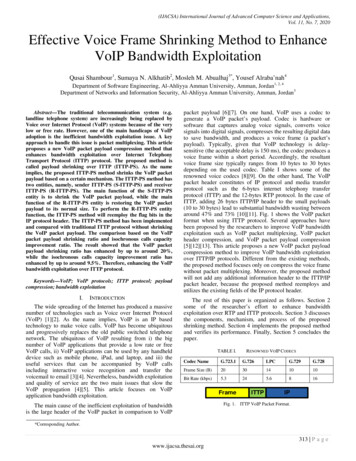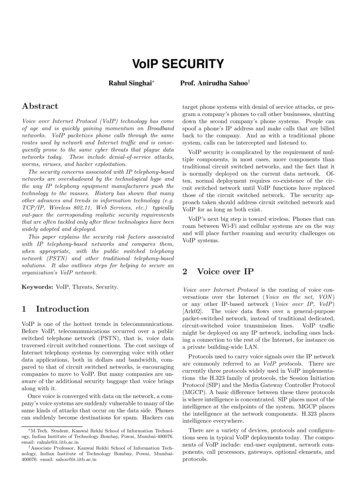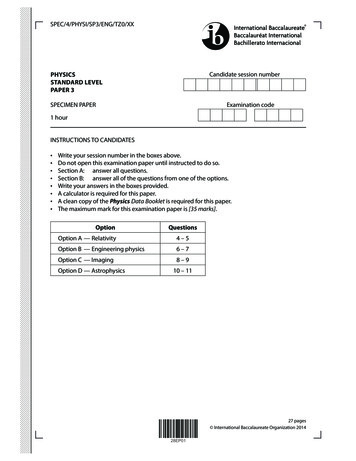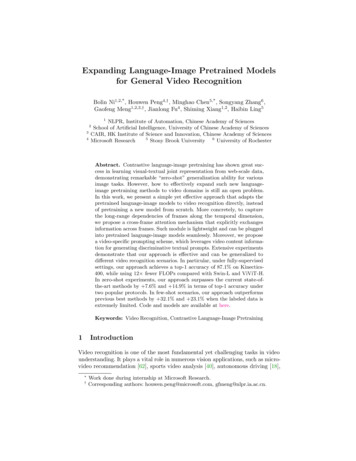
Transcription
(IJACSA) International Journal of Advanced Computer Science and Applications,Vol. 11, No. 7, 2020Effective Voice Frame Shrinking Method to EnhanceVoIP Bandwidth ExploitationQusai Shambour1, Sumaya N. Alkhatib2, Mosleh M. Abualhaj3*, Yousef Alraba’nah4Department of Software Engineering, Al-Ahliyya Amman University, Amman, Jordan1, 2, 4Department of Networks and Information Security, Al-Ahliyya Amman University, Amman, Jordan3Abstract—The traditional telecommunication system (e.g.landline telephone system) are increasingly being replaced byVoice over Internet Protocol (VoIP) systems because of the verylow or free rate. However, one of the main handicaps of VoIPadoption is the inefficient bandwidth exploitation issue. A keyapproach to handle this issue is packet multiplexing. This articleproposes a new VoIP packet payload compression method thatenhances bandwidth exploitation over Internet TelephonyTransport Protocol (ITTP) protocol. The proposed method iscalled payload shrinking over ITTP (ITTP-PS). As the nameimplies, the proposed ITTP-PS method shrinks the VoIP packetpayload based on a certain mechanism. The ITTP-PS method hastwo entities, namely, sender ITTP-PS (S-ITTP-PS) and receiverITTP-PS (R-ITTP-PS). The main function of the S-ITTP-PSentity is to shrink the VoIP packet payload, while the mainfunction of the R-ITTP-PS entity is restoring the VoIP packetpayload to its normal size. To perform the R-ITTP-PS entityfunction, the ITTP-PS method will reemploy the flag bits in theIP protocol header. The ITTP-PS method has been implementedand compared with traditional ITTP protocol without shrinkingthe VoIP packet payload. The comparison based on the VoIPpacket payload shrinking ratio and isochronous calls capacityimprovement ratio. The result showed that the VoIP packetpayload shrinking ratio has enhanced by up to around 20%,while the isochronous calls capacity improvement ratio hasenhanced by up to around 9.5%. Therefore, enhancing the VoIPbandwidth exploitation over ITTP protocol.Keywords—VoIP; VoIP protocols; ITTP protocol; payloadcompression; bandwidth exploitationI.INTRODUCTIONThe wide spreading of the Internet has produced a massivenumber of technologies such as Voice over Internet Protocol(VoIP) [1][2]. As the name implies, VoIP is an IP basedtechnology to make voice calls. VoIP has become ubiquitousand progressively replaces the old public switched telephonenetwork. The ubiquitous of VoIP resulting from i) the bignumber of VoIP applications that provide a low rate or freeVoIP calls, ii) VoIP applications can be used by any handhelddevice such as mobile phone, iPad, and laptop, and iii) theuseful services that can be accompanied by VoIP callsincluding interactive voice recognition and transfer thevoicemail to email [3][4]. Nevertheless, bandwidth exploitationand quality of service are the two main issues that slow theVoIP propagation [4][5]. This article focuses on VoIPapplication bandwidth exploitation.packet payload [6][7]. On one hand, VoIP uses a codec togenerate a VoIP packet’s payload. Codec is hardware orsoftware that captures analog voice signals, converts voicesignals into digital signals, compresses the resulting digital datato save bandwidth, and produces a voice frame (a packet’spayload). Typically, given that VoIP technology is delaysensitive (the acceptable delay is 150 ms), the codec produces avoice frame within a short period. Accordingly, the resultantvoice frame size typically ranges from 10 bytes to 30 bytesdepending on the used codec. Table I shows some of therenowned voice codecs [8][9]. On the other hand, The VoIPpacket header constitutes of IP protocol and media transferprotocol such as the 6-bytes internet telephony transferprotocol (ITTP) and the 12-bytes RTP protocol. In the case ofITTP, adding 26 bytes ITTP/IP header to the small payloads(10 to 30 bytes) lead to substantial bandwidth wasting betweenaround 47% and 73% [10][11]. Fig. 1 shows the VoIP packetformat when using ITTP protocol. Several approaches havebeen proposed by the researchers to improve VoIP bandwidthexploitation such as VoIP packet multiplexing, VoIP packetheader compression, and VoIP packet payload compression[5][12][13]. This article proposes a new VoIP packet payloadcompression method to improve VoIP bandwidth exploitationover ITTP/IP protocols. Different from the existing methods,the proposed method focuses only on compress the voice framewithout packet multiplexing. Moreover, the proposed methodwill not add any additional information header to the ITTP/IPpacket header, because the proposed method reemploys andutilizes the existing fields of the IP protocol header.The rest of this paper is organized as follows. Section 2some of the researcher’s effort to enhance bandwidthexploitation over RTP and ITTP protocols. Section 3 discussesthe components, mechanism, and process of the proposedshrinking method. Section 4 implements the proposed methodand verifies its performance. Finally, Section 5 concludes thepaper.TABLE I.RENOWNED VOIP CODECSCodec NameG.723.1G.726LPCG.729G.728Frame Size (B)2030141010Bit Rate (kbps)5.3245.6816The main cause of the inefficient exploitation of bandwidthis the large header of the VoIP packet in comparison to VoIPFrameITTPIPFig. 1. ITTP VoIP Packet Format.*Corresponding Author.313 P a g ewww.ijacsa.thesai.org
(IJACSA) International Journal of Advanced Computer Science and Applications,Vol. 11, No. 7, 2020II. RELATED WORKSThe researchers have exerted a considerable effort toenhance VoIP application bandwidth exploitation. This sectionspotlight some of these efforts over both RTP and ITTPprotocols.The first approach to enhance VoIP application bandwidthexploitation is packet multiplexing. Multiplexing approachworks by grouping the VoIP packets that are sharing the samedestination in one header, instead of a separate header to eachpacket, which highly improves bandwidth utilization. One ofthe best multiplexing methods over RTP protocol wasproposed and patented by Vulkan, Csaba, et al. in 2014. Theproposed method performs the packet multiplexing process atthe sender side gateway. In which, several packets that aresharing the same destination will be grouped in one largepacket with a single UDP/IP header. The packets areaccumulated in the large packets until it reached a specific sizeor for a predefined period of time. At the receiver sidegateway, the large packet is segregated, and the originalpackets are constructed and transmitted to their destinations[14]. Over ITTP, one of the first multiplexing methods isITTP-Mux (ITTP-Multiplexing) which was proposed in 2015.ITTP-Mux consists of two entities, namely, stream multiplexer(S-Mux) at the sender side gateway and stream de-multiplexer(S-DMux) at the receiver side gateway. At first, the S-Muxseparates the packet payload (ITTP and voice frame) from theIP header. Then, a 1-byte header is attached to the packetpayload which constitutes a mini-packet. After that, severalmini-packets are grouped in one IP header. Finally, the resultedmultiplexed packet is transmitted to its destination. The SDMux segregates the received multiplexed packet byinspecting the 1-byte header. Then, the S-DMux removes the1-byte header of each mini-packet and attaches the IP header toconstruct the original packet. Finally, the original packets aretransmitted to their destination. The performance evaluation ofthe ITTP-Mux showed that the bandwidth exploitation hasenhanced by up to 29.1% in comparison to the traditionalmethod [10].The second approach to enhance VoIP applicationbandwidth exploitation is header compression. Sandlund andPelletier have proposed then standardized a method thatcompacts the RTP/UDP/IP header from 40bytes to 2 or 4 bytes.The proposed method achieves this high compression based ontwo main features of the RTP/UDP/IP header. First, themajority of this header data is not changing throughout the calltime. Therefore, these fields are sent when establishing the calland removed from the residual of the packets. Second, some ofthe remaining data in the header are incremented by steadyvalue. Therefore, these values can be removed from the headerand calculated based on a specific equation at the receiver side[15]. Sze et al. proposed another header compression method toenhance VoIP application bandwidth exploitation. However,the proposed method has been implemented with the packetmultiplexing approach. It consists of the multiplexer (MUX)module at the sender side gateway and the demultiplexer(DEMUX) module at the receiver side gateway. The MUXmodule separate the RTP/UDP/IP header from the incomingVoIP packets, compact the RTP header, reattach the compactedRTP header to the voice frame to produce a mini-packet,combine multiple mini-packets in one large packet, andattaches the UDP/IP header to this large packet. The DEMUXmodule performs a reverse process of the MUX module toreconstruct the original VoIP packets and then, transmit themto their destinations. The size of the large packet is controlledbased on the delay, where, if the delay reaches specific valuethen the multiplexing process is stopped. The performanceevaluation of the proposed method showed that bandwidthexploitation has highly enhanced in comparison to thetraditional method [16].The third approach to enhance VoIP application bandwidthexploitation is packet payload compression. The payloadcompression can be achieved by the VoIP codec, which highlycompresses the voice data during generating the voice frame.In addition, payload compression can be achieved by voiceactivity detection (VAD) technology, which based on the factthat one of the call ends is speaking and the other one islistening. Therefore, VAD suppresses the silence instead ofsending it, which highly saves the bandwidth [3][17]. Anothermethod to compress the packet payload, called DeltaMultiplexing, was proposed by Abualhaj et al. in 2010.However, as the name implies, the Delta-Multiplexing methodhas been implemented with the packet multiplexing approach.Similar to the method proposed by Sze et al. 2002, the DeltaMultiplexing method consists of two modules, Mux andDMux, that perform almost the same process of MUX andDEMUX modules, respectively. However, instead ofcompressing the packet header, the Mux compresses the packetpayload. This is done by calculating the difference between theconsecutive voice frame based on a specific mechanism, thus,reduces the voice frame size. Then, transmit this differenceinstead of the full voice frame, thus, enhances the bandwidthexploitation. In addition, the Delta-Multiplexing method hasbeen added a 12-bits mini-header to the multiplexed minipackets to be able to restore the original voice frame size andthe original VoIP packet. The performance evaluation of theDelta-Multiplexing showed that bandwidth exploitation hasenhanced by up to 72% in comparison to the traditional method[3]. A very similar method to Delta-Multiplexing was proposedin 2019 but over ITTP protocol. In which, several VoIPpackets are multiplexed in one IP header, the same mechanismof packets payload compression is used, and a 1-byte miniheader has been added to the mini-packets to be able to restorethe original voice frame size and the original VoIP packet. Theperformance evaluation of the proposed method showed thatbandwidth exploitation has highly enhanced in comparison tothe traditional method of ITTP protocol [18]. This articleproposes a new payload compression method to enhancebandwidth exploitation over ITTP protocol. Unlike thediscussed payload compression methods, the proposed methodfocuses only on compact the voice frame without multiplexing.In addition, no extra header is needed to restore the originalsize of the voice frame, because the proposed methodreemploys and utilizes the existing fields of the IP protocolheader. The proposed method is called payload shrinking overITTP (ITTP-PS). The following section discusses the proposedITTP-PS method in detail.314 P a g ewww.ijacsa.thesai.org
(IJACSA) International Journal of Advanced Computer Science and Applications,Vol. 11, No. 7, 2020III. PAYLOAD SHRINKING OVER ITTP (ITTP-PS) METHODThe key objective of the ITTP-PS method is to shrink thevoice frame and therefore lessens its size. This leads toimproves the VoIP applications bandwidth exploitation. TheITTP-PS method will be deployed at the VoIP gateway thatconnected to the wide area network (WAN) connection, thoughit can be deployed at the client end. Several advantages can begained by deploying the ITTP-PS method at the VoIP gateway,including i) the proposed ITTP-PS method is workable with theother bandwidth exploitation approaches, such as VoIP packetmultiplexing and VoIP header compression, which aretypically deployed at the VoIP gateway, ii) the flexibly ofusing any client application from any device because it doesnot need to support ITTP-PS method, iii) the ITTP-PS methodneed to be deployed once at the VoIP gateway instead of eachclient, and iv) there is, typically, a plenty of bandwidth in localarea network in comparison to WAN connections, where thebandwidth is limited and expensive [14][15][19][20]. Fig. 2displays the location of the ITTP-PS method in a typical VoIPnetwork topology. As shown in Fig. 2, the ITTP-PS methodhas two entities. The first entity called sender ITTP-PS (SITTP-PS). The main function of the S-ITTP-PS entity is toshrink the voice frame to generate a smaller one named S-F.The second entity called receiver ITTP-PS (R-ITTP-PS). Themain function of the R-ITTP-PS entity is restoring the S-F toits normal size and generate an original-size voice framenamed O-F. The following two subsections discuss the SITTP-PS and R-ITTP-PS entities, respectively.A. S-ITTP-PS Entity FunctionThe S-ITTP-PS entity performs four main functions toshrink the voice frame: i) detach the VoIP packet header(ITTP/IP) from the VoIP packet payload (voice frame),ii) apply a specific shrinking mechanism on the voice frame toproduce S-F voice frame (as discussed below), iii) store thevalue (0 or 1) and place (start or end) of shrunk bits to berestored at the R-ITTP-PS entity (as discussed below), iv) andreattach the VoIP packet header (ITTP/IP) to the S-F voiceframe. Finally, the VoIP packet is sent to the receiver’s VoIPgateway. Fig. 3 demonstrates the S-ITTP-PS entity functions.The purpose of the shrinking mechanism is to lessen thevoice frame size. There are several operations performed bythe shrinking mechanism to lessen the voice frame size andproduce S-F voice frame. First, check whether the value of theleading bit one or zero. Second, regardless of whether theleading bit is one or zero, determine the total number of leadingbits till the bit with the opposite value of the leading bit. Third,save the number of leading bits in the leading counter (Lcount). Fourth, check whether the value of the trailing bit oneor zero. Fifth, regardless of whether the trailing bit is one orzero, determine the total number of trailing bits till the bit withthe opposite value of the trailing bit. Sixth, save the number oftrailing bits in the trailing counter (T-count). Seventh, comparethe L-count and T-count. If the L-count greater than or equalthe T-count removes the leading bits, otherwise remove thetrailing bits. These operations produce the S-F voice frame.The examples in Table II demonstrate the voice frameshrinking process at the S-ITTP-PS entity. Notably, the valuesof the voice frame in Table II are not real and are only fordemonstration purposes.As mentioned previously, the value (0 or 1) and place (startor end) of shrunk bits must be stored and sent to the R-ITTPPS entity to restore the O-F voice frame. To achieve that, theITTP-PS method will reemploy the flag bits in the IP protocolheader. The three flag bits in the IP protocol header are used tocontrol and identify fragments of the packet (if any). In thecase of VoIP, the packets are not fragmented because they aretypically very small, between 36-bytes to 56-bytes, when usingITTP protocol. Thus, the three flag bits are always set to zeroin the case of VoIP packets. Accordingly, the S-ITTP-PS entitywill use them to denote the value and place of the eliminatedbits from the voice frame. Only four possibilities are needed todenote the value and place of the eliminated bits, thus, theshrinking mechanism will use only the first two bits (4 values)of the flag bits. The denotation of four values is as follows: 00denotes shrinking the leading zeros, 01 denotes shrinking theleading ones, 10 denotes shrinking the trailing zeros, 11denotes shrinking the trailing ones.B. R-ITTP-PS Entity FunctionsThe R-ITTP-PS entity performs four main functions torestore the S-F voice frame to its original form (O-F frameform). First, detach the VoIP packet header (ITTP/IP) from theVoIP packet payload (voice frame). Second, apply theshrinking mechanism on the voice frame to restore the S-Fvoice frame to the O-F voice frame (as discussed below).Third, the flag bits in the IP protocol header are set to zero toavoid misinterpretation at the receiver client. Fourth, reattachthe VoIP packet header (ITTP/IP) to the O-F voice frame andsend the VoIP packet to its destination. Fig. 4 demonstrates theR-ITTP-PS entity functions.The purpose of the shrinking mechanism at the receiver endVoIP gateway is to restore the S-F voice frame to the O-Fvoice frame. There are two main operations performed by theshrinking mechanism to achieve this purpose. First, find thenumber (n) of shrunk bits from the O-F voice frame by SITTP-PS entity at the sender end VoIP gateway (n O-F length– S-F length). Second, restore the S-F voice frame to O-F voiceframe based on the value of the flag fields of the IP protocolheader. The denotation of the flag fields is as follows: 00denotes append n zeros at the beginning of S-F voice frame, 01append n ones at the beginning of S-F voice frame, 10 denotesappend n zeros at the end of S-F voice frame, 11 denotesappend n ones at the end of S-F voice frame. The examples inTable III demonstrate the restoration of the S-F frame to the OF frame by the R-ITTP-PS entity. These examples are the sameexamples in Table II.315 P a g ewww.ijacsa.thesai.org
(IJACSA) International Journal of Advanced Computer Science and Applications,Vol. 11, No. 7, 2020VoIP GatewayVoIP GatewaySender EndReceiver EndWAN yVoIPClientsFig. 2. Location of ITTP-PS Method’s Entities.BeginArrived PacketsExtract Voice FrameO-FO-F Frame ShrinkingS-FUpdate IP Fields ValueNew IP HeaderAttach the ITTP/IP headerto S-F FrameVoIP PacketsTransmit the VoIP Packets tothe receiver side’s VoIP gatewayEndFig. 3. S-ITTP-PS Entity Functions.TABLE II.EXAMPLES OF SHRINKING THE VOICE FRAMEO-F FrameL-CountT-CountActionS-F Frame00000110001010011000054Shrink the leading zeros because of L-Count is greater than ink the trailing zeros because of T-count is greater than ink the leading zeros because of L-Count is greater than nk the leading ones because of L-Count is greater than nk the trailing ones because of T-Count is greater than L-Count.111110110110316 P a g ewww.ijacsa.thesai.org
(IJACSA) International Journal of Advanced Computer Science and Applications,Vol. 11, No. 7, 2020BeginArrived PacketsExtract Voice FrameS-FRestore Voice FrameO-FSet IP Header Flags toZeroIP ProtocolHeaderAttach ITTP/IP header toO-F FrameVoIP PacketsTransmit the VoIP Packetsto their DestinationsEndFig. 4. R-ITTP-PS Entity Functions.TABLE III.EXAMPLES OF RESTORING THE S-F RAME TO O-F FRAMES-F FrameFlag Field ValueActionO-F Frame110001010011000000Append n zeros at beginning of the S-F voice d n zeros at end of the S-F voice frame.00011001111001110000010011100110111100Append n zeros at beginning of the S-F voice frame.00000010011100110111101001011111000010Append n ones at beginning of the S-F voice frame.11111101001011111000011111011011011Append n ones at end of the S-F voice frame.111110110110111111111IV. THE PROPESED ITTP-PS METHOD PERFORMANCEEVALUATIONThis section discusses the ITTP-PS method’s bandwidthexploitation in comparison with traditional ITTP protocolwithout shrinking the voice frame. The bandwidth exploitationwas evaluated based on two different elements, namely, voiceframe shrinking ratio (FRR) and isochronous calls capacity.For the evaluation to be sensible, three different VoIP codecs(LPC, G.723.1, and G.729) will be used to investigate thesetwo elements.A. Frame Shrinkig Ratio (FRR)This subsection investigates the ITTP-PS method’s FRRratio. The FRR is the number of shrunk bits from the voiceframe to the total number of bits of the voice frame withoutshrinking. The higher the number of shrunk bits the better thebandwidth exploitation. The FRR ratio has been investigatedwith ten different calls. The average FRR ratio of 20 VoIPpackets of each call has been calculated separately. Fig. 5displays the FRR of the LPC codec. The FRR ratio of the LPCcodec has reached around between 12.5% and 18.5%. Fig. 6displays the FRR of the G.723.1 codec. The FRR ratio of theG.723.1codec has reached around between 10% and 20%. Fig.7 displays the FRR of the G.729 codec. The FRR ratio of theG.729 codec has reached around between 7% and 15.5%.Accordingly, the ITTP-PS method accomplished a noticeablebandwidth exploitation in comparison with the traditional voiceframe without shrinking. Thus, the ITTP-PS method achievedit main objective of improving VoIP network bandwidth use.The three codecs accomplish different FRR ratio because thepattern of the voice frame of each codec is different.B. Isochronous Calls CapacityThis subsection investigates the proposed ITTP-PS methodisochronous calls capacity improvement ratio. The bandwidthexploitation improvement ratio was investigated then theisochronous calls capacity improvement ratio will have similarvalues. The bandwidth exploitation improvement ratio hasbeen investigated with 10 different calls. The averagebandwidth exploitation improvement ratio of 20 VoIP packetsof each call has been calculated separately. Fig. 8 displays thebandwidth exploitation improvement ratio of the LPC codec.The bandwidth exploitation improvement ratio of the LPCcodec has reached around between 4.5% and 6.5%. Fig. 9displays the bandwidth exploitation improvement ratio of the317 P a g ewww.ijacsa.thesai.org
(IJACSA) International Journal of Advanced Computer Science and Applications,Vol. 11, No. 7, 2020LPC Capacity ImprovementLPC CodecCapacity ImprovementG.723.1 codec. The bandwidth exploitation improvement ratioof the G.723.1codec has reached around between 5% and9.5%. Fig. 10 displays the bandwidth exploitationimprovement ratio of the G.729 codec. The bandwidthexploitation improvement ratio of the G.729 codec has reachedaround between 2% and 4.5%. Therefore, the isochronous callscapacity improvement ratio will have similar values.Accordingly, the ITTP-PS method accomplished a pretty goodisochronous calls capacity improvement ratio in comparisonwith the traditional voice frame without shrinking. Thus, theITTP-PS method achieved it main objective of improving VoIPnetwork bandwidth use. Obviously, this feature is due to theshrinking the voice frame. The three codecs accomplishdifferent isochronous calls capacity improvement ratio becausethe pattern of the voice frame of each codec is different.10%8%6%4%2%0%1345678910Call NumberFig. 8. Isochronous Calls Capacity Improvement Ratio of the LPC Codec.LPC FRRLPC CodecG.723.1 Capacity Improvement20%17%14%11%8%5%2%G.723.1 Codec12345678910Call NumberFig. 5. FRR of the LPC Codec.Capacity ImprovementFRR210%8%6%4%2%0%12345678910Call NumberG.723.1 FRRFig. 9. Isochronous Calls Capacity Improvement Ratio of the G.7321.1Codec.20%17%14%11%8%5%2%G.729 Capacity ImprovementG.729 Codec12345678910Call NumberFig. 6. FRR of the G.723.1 Codec.G.729 FRRG.729 Codec20.0%Capacity ImprovementFRRG.723.1 Codec10%8%6%4%2%0%12345678910Call Number17.0%FRR14.0%Fig. 10. FIsochronous Calls Capacity Improvement Ratio of the G.729Codec.11.0%8.0%V. CONCLUSION5.0%2.0%1234567Call NumberFig. 7. FRR of the G.729 Codec.8910VoIP has been widely adopted by private and public sectorsreplacing the traditional telecommunication systems.Nevertheless, VoIP faces a serious bandwidth exploitationinefficiency problem. This article has proposed a new method,called ITTP-PS, to alleviate this problem. The main idea of theproposed ITTP-PS method is to shrink the VoIP packet318 P a g ewww.ijacsa.thesai.org
(IJACSA) International Journal of Advanced Computer Science and Applications,Vol. 11, No. 7, 2020payload, based on certain mechanism. The ITTP-PS methodhas been deployed at the VoIP gateway that is connected to theWAN connection. The sender side VoIP gateway performsVoIP packet payload shrinking using the S-ITTP-PS entity ofthe ITTP-PS method. The receiver side VoIP gateway restoresthe VoIP packet payload to its normal size using the R-ITTPPS entity of the ITTP-PS method. The R-ITTP-PS entityachieves that by utilizing the flag bits in the IP protocol header.The ITTP-PS method has been implemented and comparedwith traditional ITTP protocol without shrinking the VoIPpacket payload. The VoIP packet payload shrinking ratio hasbeen enhanced by up to around 20% in the tested cases withthe G.723.1 codec. In addition, the isochronous calls capacityimprovement ratio has been enhanced by up to around 9.5% inthe tested cases with the same codec. Eventually, the ITTP-PShas been alleviated the bandwidth exploitation inefficiencyproblem of VoIP applications. In the future, the proposedITTP-PS method will be evaluated with different VoIP codecsto gain a more realistic evaluation. In addition, the ITTP-PSmethod will be combined with other approaches of bandwidthexploitation such as VoIP packet multiplexing.[1][2][3][4][5][6][7]REFERENCESA. Gupta, and A. Chaudhary, “A metaheuristic method to hide MP3sound in JPEG image,” Neural Computing and Applications, vol.30(5), pp. 1611-1618, Septemper 2018.Y. Zhang, K. Xie, and O. Ruan, “An improved and efficient mutualauthentication scheme for session initiation protocol,” PIoS one, vol.14(3), pp. e0213688, 2019.M. M. Abu-Alhaj, M. S. Kolhar, L. V. Chandra, O. Abouabdalla, and A.M. Manasrah, “Delta-multiplexing: A novel technique to improve VoIPbandwidth utilization between VoIP gateways,” 2010 10th IEEEInternational Conference on Computer and Information Technology, pp.329-335, June 2010.T. T. Nguyen, and G. Armitage, “A survey of techniques for internettraffic classification using machine learning,” IEEE communicationssurveys & tutorials, vol. 10(4), pp.56-76, 2008.M. M. Abualhaj, M. M. Al-Tahrawi, and S. N. Al-Khatib, “A NewMethod to Improve Voice over IP (VoIP) Bandwidth Utilization overInternet Telephony Transport Protocol (ITTP),” Proceedings of the 20198th International Conference on Software and Information Engineering,pp. 192-195, April 2019.S. Seytnazarov, and K. Young-Tak, “QoS-aware adaptive A-MPDUaggregation scheduler for enhanced VoIP capacity over aggregationenabled WLANs,” NOMS 2018-2018 IEEE/IFIP Network Operationsand Management Symposium, IEEE, pp. 1-7, 2018.B. Maqhat, M. D. Baba, R. Ab Rahman, and A. Saif, “Performanceanalysis of fair scheduler for A-MSDU aggregation in IEEE802. 20]wireless networks,” 2014 2nd International Conference on Electrical,Electronics and System Engineering (ICEESE), IEEE, pp. 60-65, 2014.E. Charfi, L. Chaari, and L. Kamoun, “Joint Urgency Delay schedulerand adaptive aggregation technique in IEEE 802.11 n networks,” 20155th International Conference on Communications and Networking(COMNET), IEEE, pp. 1-6, 2015.H. Sathu, and A. S. Mohib, “Performance comparison of VoIP codecson multiple operating systems using IPv4 and IPv6,” InternationalJournal of e-Education, e-Business, e-Management and e-Learning, vol2(2), pp. 122-125, 2012.M. M. Abualhaj, “ITTP-MUX: An efficient multiplexing mechanism toimprove voip applications bandwidth utilization,” International Journalof Innovative Computing Information and Control, vol. 11(6), pp. 20632073, 2015.M. M. Abualhaj, S. N. Al-Khatib, M. Kolhar, A. Munther, and Y.Alraba’nah,”Effective Voice Frame Pruning Method to Increase VoIPCall Capacity,” TEM Journal, vol. 9(1), pp. 48-54, 2020.M. O. Ortega, G. C. Altamirano, C. L. Barros, and M. F. Abad,“Comparison between the real and theoretical values of the technicalparameters of the VoIP codecs,” 2019 IEEE Colombian Conference onCommunications and Computing (COLCOM), pp. 1-6, June 2019.K. Sandlund, G. Pelletier, and LE. Jonsson, “The robust headercompression (rohc) framework,” RFC 5795, March 2010.C. Vulkan, A. Rakos, Z. Vincze, and A. Drozdy, “Reducing overhead onvoice traffic,” U.S. Patent No. 8,824,304, Septemper 2014.P. Fortuna, and M. Ricardo, “Header compressed VoIP in IEEE 802.11,”IEEE Wireless communications, vol. 16(3), pp. 69-75, 2009.H. P. Sze, S. C. Liew, J. Y. Lee, and D. C. Yip, “A multiplexing schemefor H. 323 voice-over-IP applications,” IEEE Journal on Selected Areasin Communications, vol. 20(7), pp. 1360-1368, 2002.A. Sangwan, M. C. Chiranth, H. S. Jamadagni, R. Sah, R.V. Prasad, andV. Gaurav, “VAD techniques for real-time speech transmission on theInternet,” In 5th IEEE International Conference on High SpeedNetworks and Multimedia Communication (Cat. No. 02EX612), pp. 4550, 2002.M. M. Abualhaj, “CA-ITTP: An efficient method to aggregate voippackets over ittp protocol,” International Journal of InnovativeComputing, Information and Control (IJICIC), vol. 15(3), pp. 10671077, 2019.S. K. Manjur, M. Abu-Alhaj, O. Abouabdalla, T. C. Wan, R. Budiarto,and A. M. Manasrah, “Conference gateway for heterogeneous clients:Real time switching clients and interasterisk exchang
the original voice frame size and the original VoIP packet. The performance evaluation of the proposed method showed that bandwidth exploitation has highly enhanced in comparison to the traditional method of ITTP protocol [1]. This article 8 proposes a new payload compression method to enhance bandwidth exploitation over ITTP protocol. Unlike the










